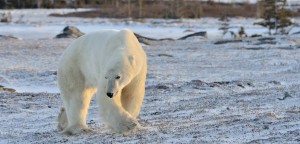
We have observed a greater degree of warming in the Arctic than other parts of the world.
Sea ice and snow cover are diminishing. The permafrost is thawing. These significant changes are altering the landscape of the Arctic, and have big implications for the people and animals that live there.
Temperature
The average warming observed in the Arctic has been approximately double that observed in other parts of the world, with the greatest warming trend occurring during the winter months. In certain regions, such as Alaska and parts of Western Canada, the mean winter temperature has increased by approximately 3-4°C during the later half of the twentieth century (1).
Precipitation
The amount and type of precipitation that falls in Arctic regions has changed during the past century. It is currently estimated that precipitation in the region has increased by approximately 8% during this time, with much of this increase falling as rain during the winter months (1).
Other changes
Changes to temperature and precipitation patterns are not the only effects of climate change being observed in the Arctic: (1)
- Snow cover in the Arctic has decreased by about 10% in the past few decades
- Permafrost is melting, causing problems for infrastructure stability
- Arctic sea ice is forming later in the fall, and retreating earlier in the spring




